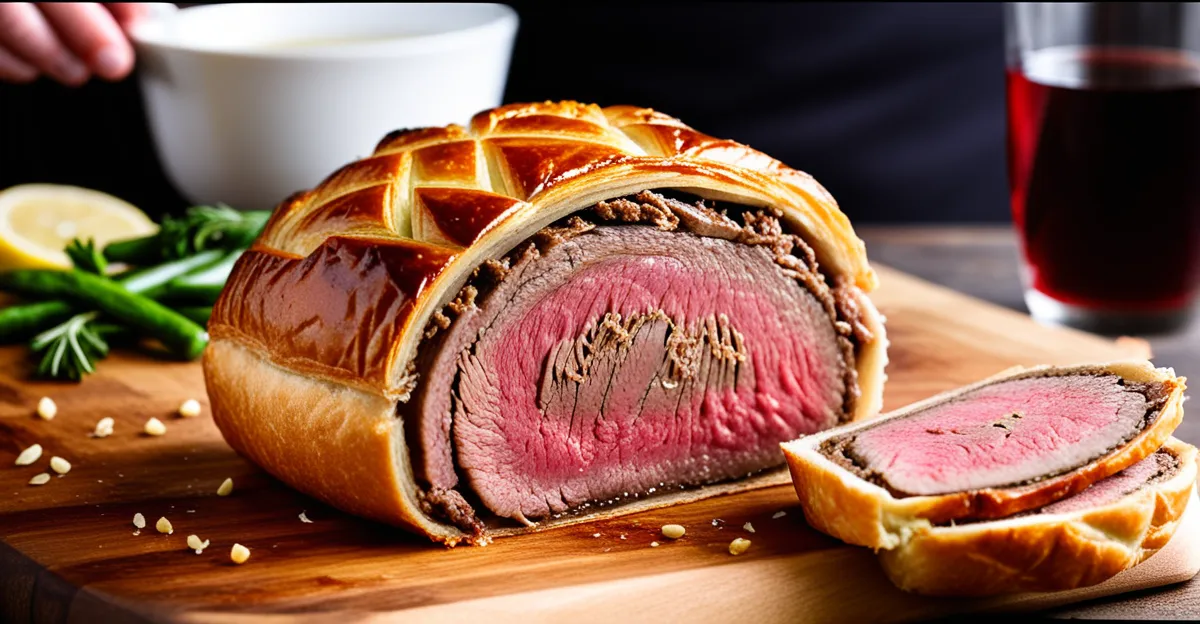Essential Techniques for the Perfect Beef Wellington
Mastering beef Wellington techniques starts with a precise and thoughtful approach to each stage of the cooking journey. The beef Wellington process involves several key steps, beginning with properly preparing the filet mignon. Searing the beef quickly seals in juices—an expert beef Wellington tip critical to maintaining succulent meat throughout baking.
Next is crafting the mushroom duxelles, where finely chopped mushrooms are cooked down to remove moisture, preventing sogginess later. This step is essential for achieving the perfect beef Wellington, as it creates a flavor-packed barrier.
In the same genre : How can you elevate a traditional toad in the hole?
When it comes to wrapping, the pastry’s quality and handling dictate the overall crust texture. Expert beef Wellington tips highlight the importance of chilling the wrapped beef before baking to prevent the pastry from splitting or becoming soggy.
Timing and temperature control during baking are critical. Cooking at a high temperature initially helps crisp the pastry, then lowering the heat ensures the beef reaches the desired medium-rare without drying. Following these techniques results in a harmonious balance of flaky crust and tender beef, hallmarks of a perfect beef Wellington.
Also read : How can you create a deliciously authentic toad in the hole?
Choosing the Best Ingredients for Beef Wellington
Selecting the right beef Wellington ingredients is foundational to a perfect beef Wellington. The choice of filet mignon directly impacts tenderness and flavor. Aim for a high-quality, well-marbled cut; this ensures juicy, flavorful beef after searing and baking.
Mushrooms play a vital role in the beef Wellington process through the mushroom duxelles, which must be finely chopped and cooked until moisture evaporates. Avoid watery duxelles to prevent sogginess. Incorporating prosciutto as a moisture barrier is another expert beef Wellington tip; it adds flavor while protecting the pastry.
For the pastry, selecting a high-quality puff or shortcrust pastry with good flakiness and strength is critical. This type withstands moisture during baking, achieving that sought-after crisp, flaky crust that encases the beef perfectly. Chilling the pastry before wrapping also enhances its texture.
In sum, prioritizing premium filet mignon selection, properly prepared mushroom duxelles, and sturdy, flaky pastry ensures every component contributes to a cohesive and delicious beef Wellington masterpiece. These ingredient choices are the backbone of expert preparation and successful results.
Assembly Secrets from Professional Chefs
Understanding beef Wellington assembly is crucial for a flawless dish. Chefs emphasize layering to balance flavor and moisture. Start with the mushroom duxelles spread evenly over the prosciutto-wrapped beef to create an effective moisture barrier. This prevents sogginess and enhances taste.
When it comes to beef Wellington wrapping, handling the pastry delicately is key. Roll it to a uniform thickness and ensure it completely encloses the meat without gaps. Expert beef Wellington tips recommend sealing edges tightly with egg wash, which acts like edible glue, reducing the risk of splitting.
Chilling plays a vital role across assembly stages. After wrapping, refrigerate the wellington to firm up the pastry, allowing for precise cuts and maintaining structure during baking. This step also enables the flavors to meld, improving overall taste.
Skipping proper assembly or chilling can cause pastry failure or uneven cooking. Following these professional tips ensures a crisp pastry crust that complements tender beef perfectly—essential to mastering the beef Wellington process and achieving a truly perfect beef Wellington.
Avoiding Common Beef Wellington Mistakes
Avoiding typical beef Wellington mistakes is crucial to delivering a flawless dish. One frequent error is overcooking the beef. Cooking beyond medium-rare compromises tenderness, so expert beef Wellington tips stress closely monitoring internal temperatures—ideally using a meat thermometer. The target internal temperature should be about 125°F (52°C) before resting, ensuring a perfect medium-rare finish.
Another common pitfall is soggy pastry, often caused by excess moisture from undercooked duxelles or skipping the prosciutto layer. Make sure the mushroom duxelles are cooked thoroughly to evaporate moisture. Adding a dry, thin prosciutto wrap serves as a moisture barrier, preventing the pastry from becoming wet.
Before baking, verify the pastry is sealed tightly with egg wash, which deters splitting. Chilling the wrapped Wellington solidifies the dough and firms up flavors for even cooking. By following these checkpoints in the beef Wellington process, you significantly reduce the chance of a soggy bottom or pastry failure—common errors that undermine the beauty of a perfect beef Wellington.







